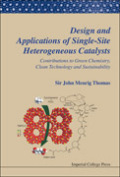
Design and applications of single-site heterogeneous catalysts: contributions to green chemistry, clean technology and sustainability
Thomas, John Meurig
For far too long chemists and industrialists have relied on the use of aggressive reagents such as nitric and sulphuric acids, permanganates and dichromates to prepare the massive quantities of both bulk and fine chemicals that are needed for the maintenance of civilised life — materials such as fuels, fabrics, foodstuffs, fertilisers and pharmaceuticals. Such aggressive reagents generate vast quantities of environmentally harmful and often toxic by-products, including the oxides of nitrogen, of metal oxides and carbon dioxide. Now, owing to recent advances made in the synthesis of nanoporous solids, it is feasible to design new solid catalysts that enable benign, mild oxidants to be used, frequently without utilising solvents, to manufacture the products that the chemical, pharmaceutical, agro- and bio-chemical industries require. These new solid agents are designated single-site heterogeneous catalysts (SSHCs). Their principal characteristics are that all the active sites present in the high-areasolids are identical in their atomic environment and hence in their energy ofinteraction with reactants, just as in enzymes. Single-site heterogeneous catalysts now occupy a position of growing importance both academically and in their potential for commercial exploitation. This text, the only one devoted to such catalysts, dwells both on principles of design and on applications, such as the benign synthesis of nylon 6 and vitamin B3. It equips the reader with unifying insights required for future catalytic adventures in the quest for sustainability in the materials used by humankind. Anyone acquainted with the language of molecules, including undergraduates in the physical and biological sciences, as well as graduates in engineering and materials science, should be able to assimilate the principles and examples presented in this book. Inter alia, it describes how clean technology and ‘green’ processes may be carried outin an environmentally responsible manner. INDICE: Basics and Background: Introduction to the Salient Features of Single-Site Heterogeneous Catalysts; Lessons from the Biological World: The Kinship between Enzymes and Single-Site Heterogeneous Catalysts; Distinctions between Single-Site Heterogeneous Catalysts and Immobilized Homogeneous Catalysts; Microporous Open Structures: Microporous Open Structures for the Design of NewSingle-Site Heterogeneous Catalysts; Single-Site Heterogeneous Catalysts for the Production of Pharmaceuticals, Agrochemicals, Fine and Bulk Chemicals; Mesoporous Open Structures: Epoxidations and Sustainable Utilization of RenewableFeedstocks, Production of Vitamin E Intermediates, Conversion of Ethene to Propene and Solvent-Free, One-Step Synthesis of Esters; Exploiting Nanospace forAsymmetric Conversions; Multinuclear, Bimetallic Nanocluster Catalysts.
- ISBN: 978-1-84816-910-4
- Editorial: Imperial College
- Encuadernacion: Rústica
- Páginas: 324
- Fecha Publicación: 16/06/2012
- Nº Volúmenes: 1
- Idioma: Inglés
